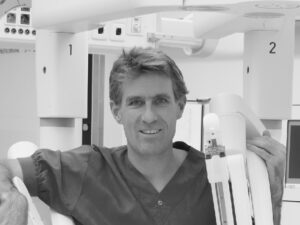Over the last twenty years, a lot has changed in terms of robotic surgery. Robots have improved a lot these past few years, and we currently perform surgeries with robots that we could never do without a robot. The Netherlands currently has thirty-five surgical robots, divided among thirty hospitals. The UMCU Utrecht has two of these robots, and there is a total of five of them in the hospitals working with the UMC Utrecht in the RAKU-partnership. The market for surgical robots is booming!
Surgical robots as optimal extension of the surgeon
Performing surgery with a robot has many advantages. Using the robot, the surgeon can execute minuscule movements, because the specialist’s movements are scaled down for execution in real-time. It also has three-dimensional, enlarged visuals, and instruments with joints that can rotate. This allows surgeons to work more precisely. By now, robots are used in many different operations at the UMCU, such as oesophageal cancer, gastric cancer, thyroid cancer, gynaecological cancer, liver and bladder tumours, and even heart surgery.
The computer will play a bigger part in the future
The developments in the field of robotic surgery happen quickly, and there’s more and more proof of the added value of a surgical robot. A great advantage of the surgical robot is that there’s a computer in between the surgeon and the patient. This makes it possible, for instance, to integrate pre-op MRI or CT images with live images of the surgery. These images can contribute to the recognition of anatomical structures and the identification of what needs to be removed during the surgery. It’s also expected that artificial intelligence will continue to play a larger part in robotic surgery in years to come. Pattern recognition during operations leads to a better understanding of human activity, and can possibly prevent complications during surgeries.
“I imagine that robot will say: “pay attention, you will want to turn left, but most people in similar situations turn right and obtain better results.”
Through collecting and sharing more and more surgical data globally, these algorithms will function better and better. Whether patients are open to undergoing surgery performed by a surgical robot? They won’t say: ‘I want you to operate using only your hands, without any support.’
A favourable cost-benefit ratio of the surgical robot is essential for large-scale adaptation
Aside from the possibilities for innovation, it’s also very important to look at the cost-effectiveness of robotic surgery. The technology can only be used sustainably if the costs in proportion to the added value. The acquisition and maintenance costs are still very high. This is partially because there was only one supplier until now: Intuitive Surgical with the Da Vinci Robot. My expectation is that four or five suppliers will be added to that as soon as next year, and in the coming years there will be dozens. The cost-benefit ratio will therefore shift, favourably, in the future. In addition, simpler robots will also enter the market, which will only execute one task.
Besides well-developed and supported implementation processes, it’s essential for large-scale adaptation to embed moments for evaluation into the development process of technology, and to investigate the optimal use. For sometimes, a new technology is only cost-effective if it replaces old technology. If the implementation fails, care institutions would be using two technologies alongside each other, which is more expensive.
Future surgeons are more educated, but also more explicitly involved in the development
For future surgeons as well as surgical assistants, nurses, and researchers, a robotic surgery course is indispensable. The education surrounding robotic surgery has to evolve and start training surgeons earlier on in performing surgery for different afflictions using a robot. This is happening more and more. With the Dutch robotic surgery seminar, for example, we organise congresses and training in order to share knowledge and improve patient care.
It’s also necessary for surgeons, ultimately the users, to be involved in the development of such robots at an earlier stage. We’re invited to test days and have the opportunity to provide feedback, but it’s still mostly technicians that come up with the technology and develop it. I hereby call for the more intensive involvement of eventual users in the development of technology, in order to accelerate its implementation.
A delta plan leads to more effective use of surgical robots
In ten years, I expect every operating theatre to feature a surgical robot. Robotic surgery, in all its shapes and forms, will be deemed a basic requirement for performing surgery successfully. Of course this requires large investments, but collaborating is a solution to that. Hospitals throughout the country should join forces by means of a delta plan. Besides sharing knowledge and expertise, surgical capacities can be compiled, with the aim of shortening waiting lists and decreasing costs. Without losing quality of care, naturally. In the end, not every hospital needs all possible robots, but specialised centres can emerge. Besides the fact that hospitals should collaborate on this, it also requires explicit involvement of other parties such as the government, insurance providers, and research institutes. After all, no one can innovate healthcare on their own. It takes a well-coordinated, multidisciplinary approach, which also involves the target audience. Shared understanding, a common language, and a shared vision are of great importance!

